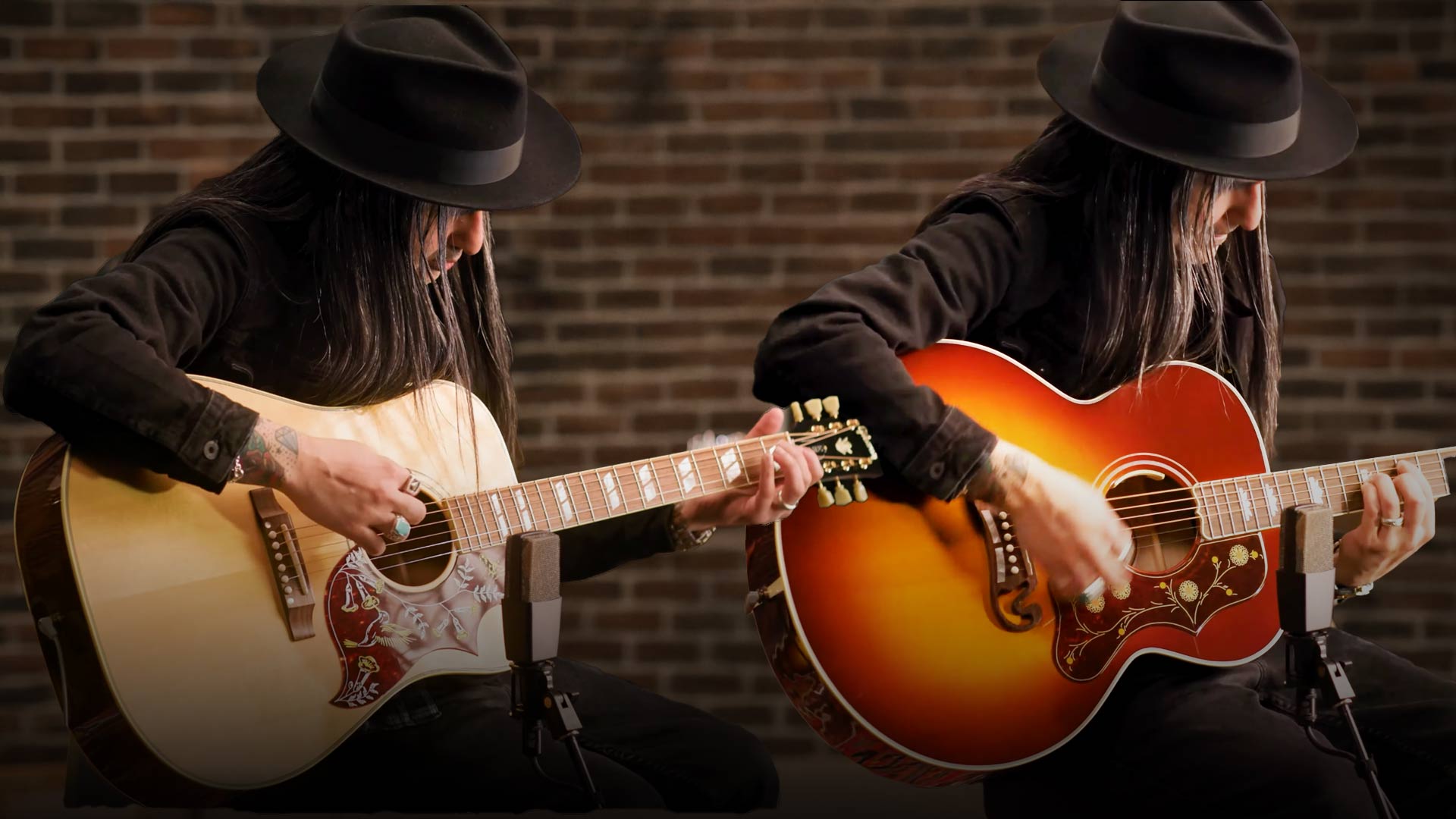Let’s examine the differences between the Gibson Hummingbird and Gibson SJ-200 so you can decide which acoustic guitar is right for you
You’re here because you can’t decide between the two major players in the Gibson Acoustic lineup, and you want to know the difference between the Gibson Hummingbird™ vs Gibson SJ-200™ acoustic guitars. Well, you’ve come to the right place! I’ll give you a quick Gibson acoustic comparison showing the unique features and differences between these two titans of the acoustic guitar world.
Firstly, when it comes to acoustic guitars, Gibson is the gold standard and relied upon by your favorite artists, so either acoustic guitar will play great and suit any style. Don’t worry too much—you won’t get it “wrong,” but there are a few key differences between the models and characteristics that certain guitarists gravitate towards. Personally, I love the “boom” of the SJ-200 when playing solo acoustic, but I prefer the Hummingbird in a band situation—but that’s just me.
These Gibson acoustic models have been around for decades and have helped shape the sound of music, so your new guitar will quickly become your favorite guitar. The Hummingbird and the SJ-200 have been used by the world’s greatest artists—Keith Richards was renowned for using a Gibson Hummingbird and George Harrison was a fan of the SJ-200—so you’re joining a family when you pick up one of these.
Again, both instruments are classics in their own right, but what’s the difference? Let’s get into the details of what the major differences are between the Gibson Hummingbird and the Gibson SJ-200 so you can decide which one is right for you.
What’s the main difference between the Gibson Hummingbird vs the Gibson SJ-200?
The main differences between the Gibson Hummingbird and the SJ-200 are in their body styles and tonal qualities. The Hummingbird features a square-shouldered dreadnought body for a midrange-rich tone, ideal for singer-songwriters. The SJ-200’s large Super Jumbo body shape and narrower waist delivers bold projection and enhanced bass and treble, perfect for ensemble settings and country music.
Gibson Hummingbird and SJ-200 history
Gibson acoustic guitars are the foundation of many classic songs and loved by musicians everywhere—I can certainly guarantee that you have an album in your record collection on which one of these guitars featured.
Gibson has a long history and expertise in building acoustic guitars. The Hummingbird was introduced in 1960 and became the go-to guitar for singer-songwriters for tone and also looks, thanks to its distinctive pickguard design. The SJ-200 has been on stages since 1937 and is known as the “King of the Flat-Tops” for its grand presence and commanding sound. It is still being made today using the same historic methods of construction.
Gibson Hummingbird acoustic guitar features
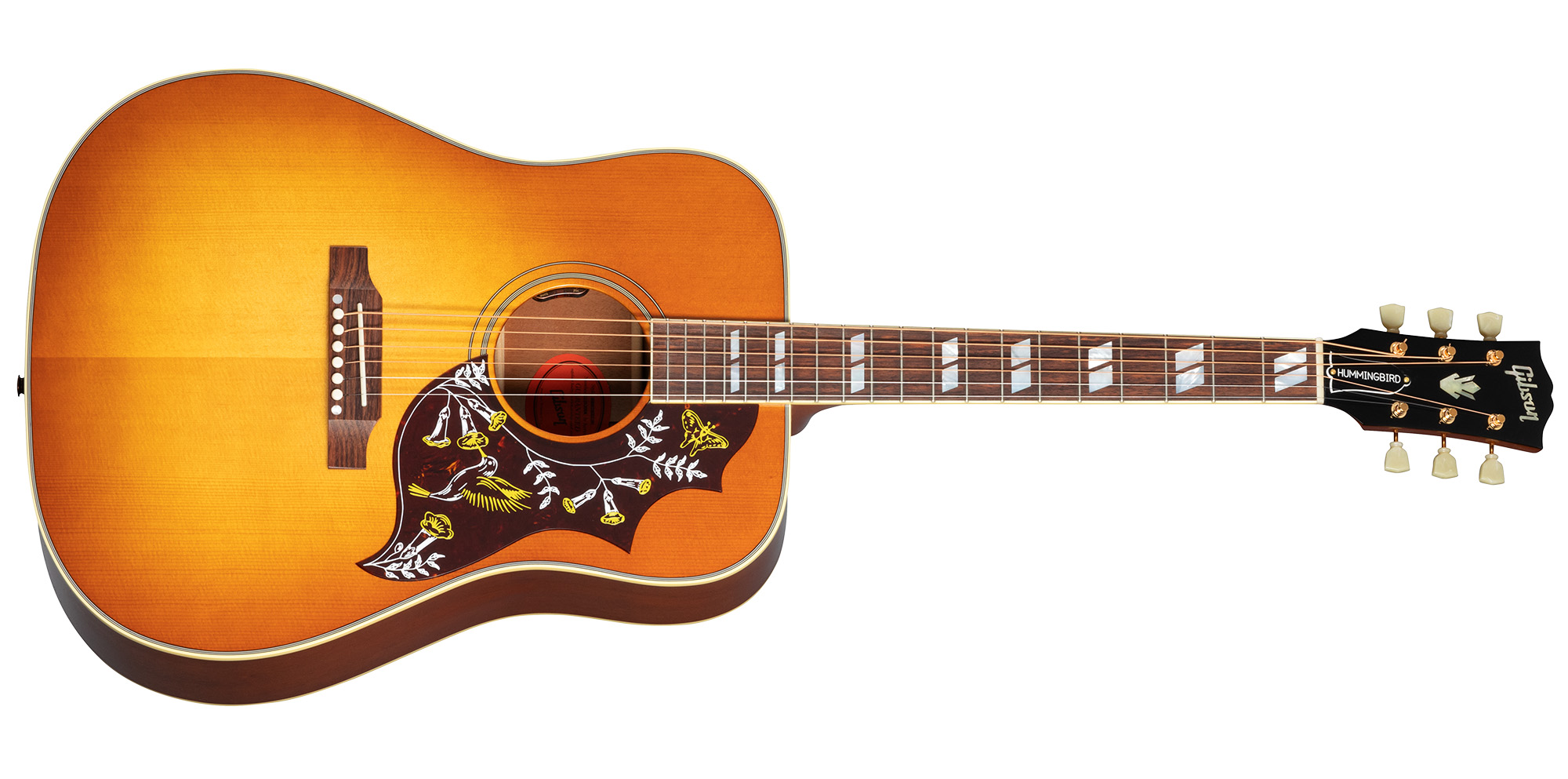
Pictured: Gibson Hummingbird Original Heritage Cherry Sunburst
Body and looks
The Hummingbird is unmistakable with its square-shouldered dreadnought body and Hummingbird pickguard. The Heritage Cherry Sunburst finish, the fan-favorite finish it’s most often seen in, is a real showstopper on any stage and just looks so damn cool.
Build and materials
In the example in the video above, we went with the Gibson Hummingbird Original as featured in the video, but tonewoods and construction can vary from iteration to iteration. There’s even a cutaway version, launched in 2024.
- Top: Solid Sitka spruce
- Back and sides: Solid mahogany
- Neck: Mahogany
- Fretboard: Rosewood with split parallelogram inlays
Every guitar is handcrafted in the time-honored fashion by our luthiers in Bozeman, Montana.
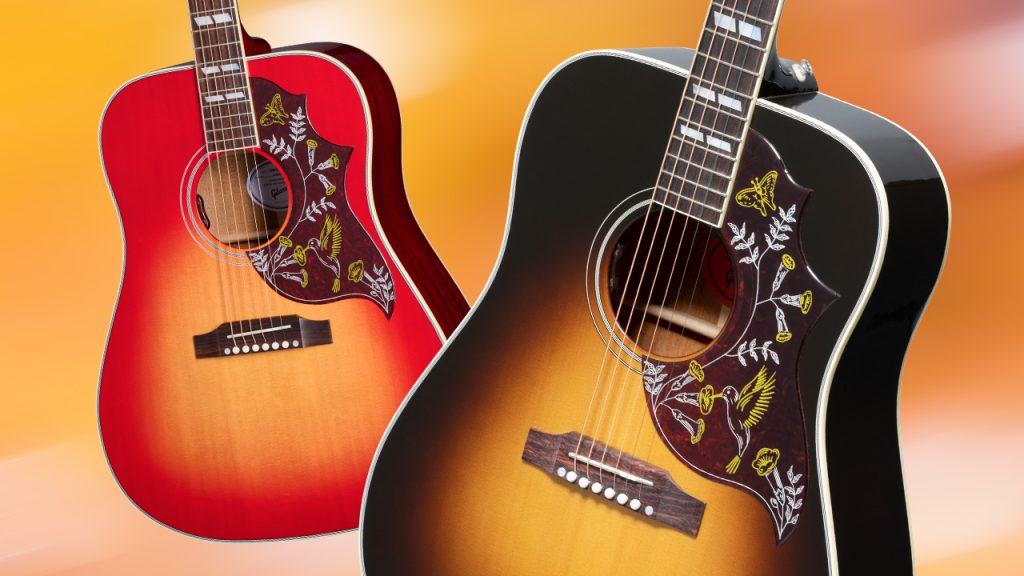
Image: The Gibson Hummingbird features split parallelogram inlays and that unmistakable pickguard
What does the Gibson Hummingbird sound like?
The signature sound of mahogany gives the Hummingbird a warm foundation, and the spruce top adds clarity and attack. The square-shouldered design produces a full-bodied sound with plenty of bass. It’s great for strumming chords or fingerstyle playing.
The mahogany back and sides provide a rich midrange for accompanying vocals. It’s often used by singers who are in a band setting, as it doesn’t overpower the rest of the band. Over the years, the Hummingbird has been widely praised as a great all-rounder acoustic guitar that is ideal for people fronting bands, band leaders, and singer-songwriters.
Electronics and Hardware
- Tuners: Vintage Deluxe with gold hardware
- Electronics: L.R. Baggs™ VTC under-saddle pickup with volume and tone controls inside the soundhole
Electronics are onboard, so the Hummingbird is stage-ready and sounds like a great acoustic guitar should when amplified.
What’s so special about the Gibson Hummingbird?
The Gibson Hummingbird, introduced in 1960, was Gibson’s first square-shouldered dreadnought. Known for its warm, midrange-rich tone from a solid Sitka spruce top and mahogany back and sides, it excels in folk, rock, and country. Iconic for its detailed pickguard and sunburst finish, modern versions feature L.R. Baggs™ VTC electronics for excellent amplified sound.
Gibson SJ-200 acoustic guitar features
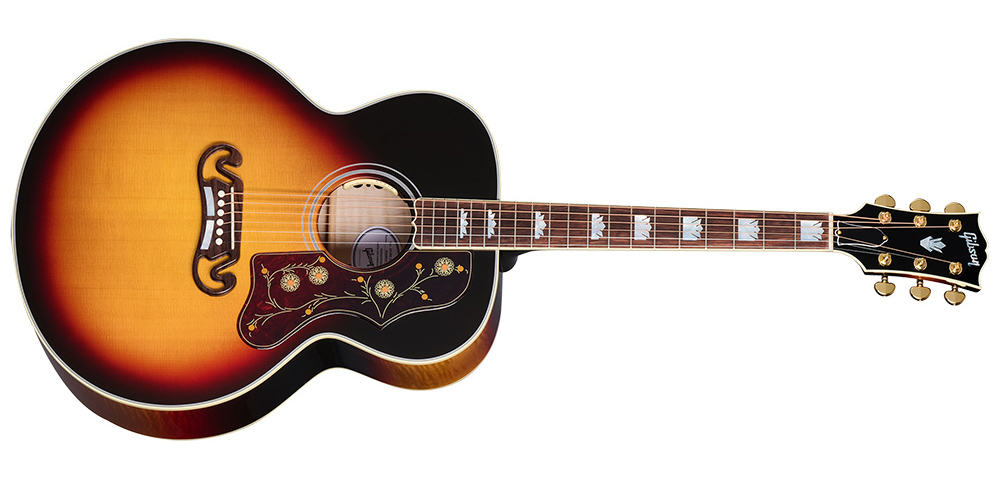
Pictured: Gibson SJ-200 Standard Tri Burst
Body and looks
With its Super Jumbo body and premium appointments, the SJ-200 is a showstopper. Crown fretboard inlays, flame maple back and sides, and the moustache™ bridge–it’s instantly recognizable and has been used by the likes of Pete Townshend and Johnny Cash. This guitar is perfect for solo singer-songwriters and has plenty of stage presence and projection.
Build and materials
Note that in this blog, I’m referencing the tonewoods featured on the guitar in the video—but they can vary depending on model versions.
- Top: Solid Sitka spruce
- Back and sides: Solid flamed maple
- Neck: Maple
- Fretboard: Rosewood
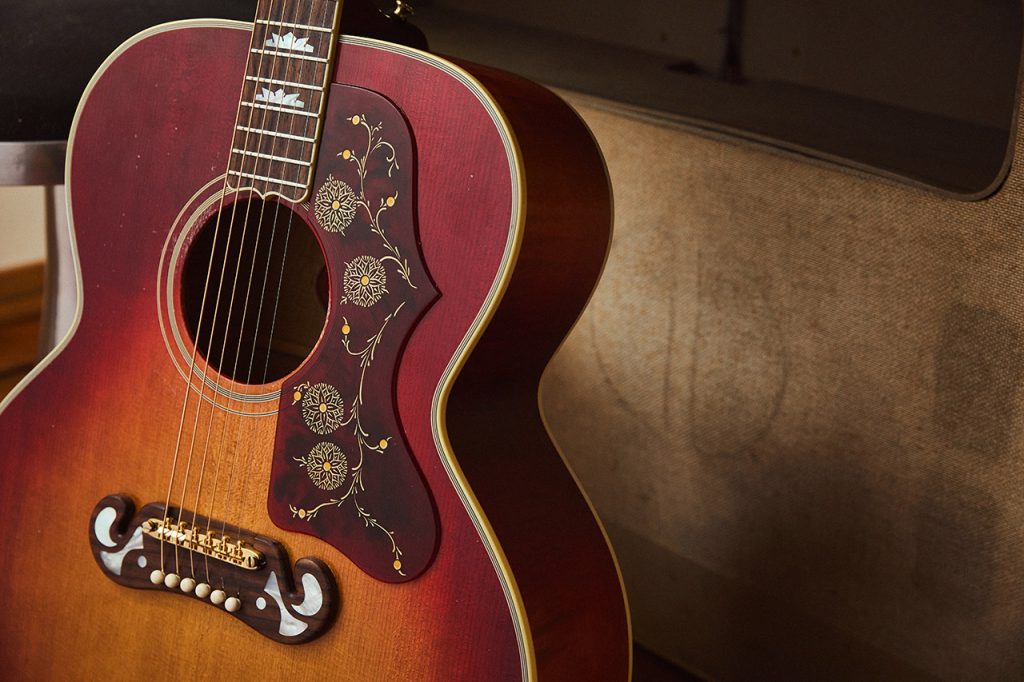
Image: The Jimmy Page 1964 SJ-200 is the pinnacle of the SJ-200 experience
What does the Gibson SJ-200 sound like?
The SJ-200 is known as a “big-box strummer.” It has more low end and more projection, but also a percussive quality when strummed and plenty of clarity thanks to its narrower waist. The maple back and sides and the Super Jumbo body give it a balanced tone with clear highs and big lows. It’s great for holding down the rhythm in a band or cutting through a mix with its presence–but be warned: this is one of the loudest acoustic guitars known to humankind.
What’s so special about the Gibson SJ-200
The Gibson SJ-200, released in 1937, stands out as the “King of the Flat-Tops” due to its Super Jumbo body, solid Sitka spruce and flamed maple build, and exceptional tone projection. It is celebrated for its bold sound, suitable for rhythm players and singers, and its iconic design admired by legends like Johnny Cash and many more artists.
Electronics and Hardware
- Tuners: Gold Grover® Rotomatics®
- Electronics: L.R. Baggs Anthem system with under-saddle pickup and internal condenser microphone. Blendable mix with phase switch and blend control.
Side-by-side comparison
Body style and size differences
- Hummingbird: square-shouldered dreadnought
- SJ-200: Super Jumbo
The Hummingbird is slightly smaller compared to the SJ-200, and some guitarists find it a touch more comfortable to play when seated or standard due to its dreadnought proportions. The SJ-200 has a bigger body (the clue is the SJ in its name, which means Super Jumbo!), which can take some getting used to.
Tonewood differences
- Hummingbird: Mahogany back and sides; warm and woody
- SJ-200: Flamed maple back and sides; bright and clear
Sound and projection differences
- Hummingbird: Midrange-rich; great for singer-songwriters and fingerstyle players
- SJ-200: Big projection; ideal for strumming and ensemble use
Playability differences
Both instruments offer a stellar playing experience, but the Hummingbird might be slightly better suited to players who are playing seated, while the SJ-200 is ideal for those who are comfortable with a larger guitar and are playing standing. However, music history tells us there are no hard and fast rules!
What genres are these guitars best suited for?
- Hummingbird: Folk, country, rock, blues, or any musical application where warm, rich acoustic tones are required
- SJ-200: Country, rock, pop, or any genre where strong rhythm strumming is key, especially if you have a single acoustic guitar player driving the band
Over the years, the Hummingbird and SJ-200 have featured in almost every music genre and again, there are no rules.

Pictured: Gibson Hummingbird Standard in Vintage Sunburst
Who is the Gibson Hummingbird for?
The Gibson Hummingbird is a supremely versatile guitar for players who appreciate a full, balanced tone with rich mids and warmth. Here’s where the Hummingbird really shines, based on how I’ve used it and seen it being used:
- Folk and singer-songwriter: The Hummingbird’s warmth and strong midrange make it perfect for vocal accompaniment; the guitar can sit in a mix without overpowering the vocals
- Rock: This is one of the most iconic rock acoustic guitars. It fits perfectly with other acoustics and lends itself incredibly well to both lead guitar lines, riffs, and big strumming chorus lines—just ask Keith Richards
- Country: Responsive low-end and articulate highs for fingerpicking or strumming. It has a classic country tone that works well with other guitars and any voice
- Blues: For blues players, the Hummingbird’s woody resonance and punchy mids give each note soul, fingerpicked or played with a slide
- Acoustic rock: Strummed, the Hummingbird is a driving force. Its classic, full-bodied Gibson tone is perfect for acoustic rock and works exceptionally well sitting in the mix with other guitars
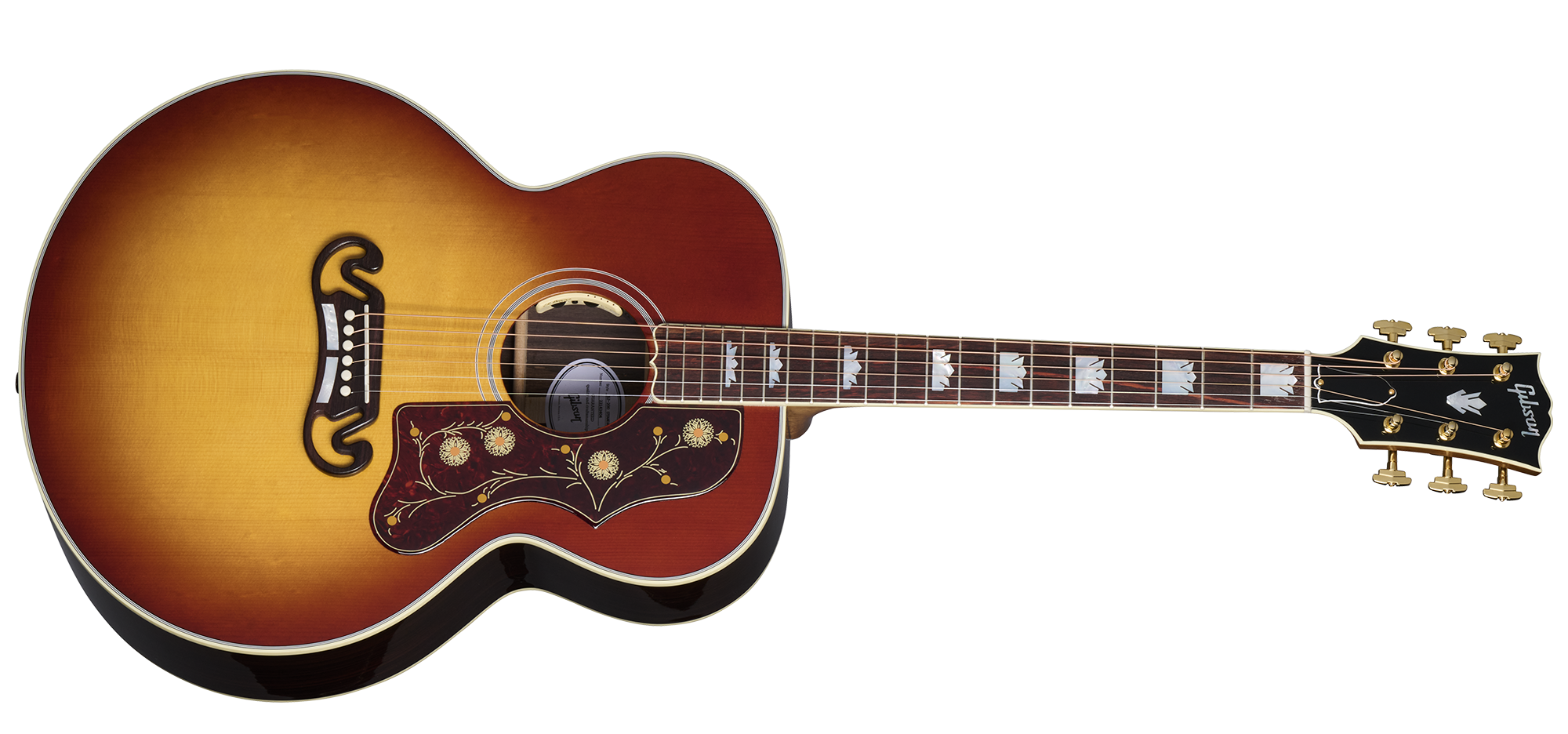
Pictured: Gibson SJ-200 Standard Rosewood in Rosewood Burst
Who is the Gibson SJ-200 for?
The Gibson SJ-200 is a big instrument with plenty of presence and it is ideal for players who want volume, balance, and a bold sound. Here’s where the SJ-200 really shines:
- Rock and pop–basically anything! With its projection and punch, the SJ-200 holds down the rhythm section in rock and pop music, and gives you a strong backing instrument if you’re the lead singer
- Band settings and ensembles: The SJ-200’s grand projection allows it to cut through a mix. It’s a favorite for players in ensemble settings or with other amplified instruments where you need to stand out
- Country & Western: The SJ-200’s bright and clear tones and wide dynamic range give classic country music a rich cinematic feel when strumming chords or playing big lead lines–it’s hard to think of classic country music without this acoustic guitar
- Americana and folk-rock: This guitar’s tonal complexity is perfect for driving Americana, roots, and folk-rock styles, especially for players who want a guitar that sits perfectly in a mix, with rich harmonics and balanced clarity that complements a vocal
Should I choose a Gibson Hummingbird or SJ-200?
It all comes down to your personal preference and playing style, but here’s what I’d recommend when it comes to choosing a Gibson Hummingbird vs Gibson SJ-200 after playing both of them in band settings and individually.
Go with the Hummingbird if you:
- Want the classic look of the Hummingbird pickguard
- Like a warm acoustic guitar sound with strong mids
- Fingerpick, play slide, or need an all-rounder acoustic for multiple styles
Go with the SJ-200 if you:
- Want a guitar with a grand presence on stage (because we all know appearances matter!)
- You need projection and a balanced tone that cuts through a mix
- You’re a strummer or play in a band setting where you are the only guitarist, or you are the front person and need to stand out sonically and visually
Ultimately, trying out different Gibson acoustic guitars, including the SJ-200 and the legendary Gibson J-45™, is the key to finding the right one for you. Every Gibson acoustic guitar is handcrafted and unique, and there’s no substitute for just playing a bunch of them and finding the guitar that speaks to you. Or do what I do and get multiple guitars for different scenarios!
Try both of these classic Gibson acoustics
Both the Hummingbird and SJ-200 are legendary Gibson acoustic guitars. You cannot go wrong with either option and it’s not really a game of “Hummingbird vs Gibson SJ-200” with an obvious winner. They’re both different designs, suitable for different genres, but still with lots of crossover. Try them both, and I can 100 percent guarantee you’ll find incredible qualities that suit your playing style with either option. Be warned: you’ll probably be like me and want to buy them both.
Want to see more Gibson acoustic guitar comparisons, including the Hummingbird vs Gibson SJ-200 and many other Gibson acoustics? Watch the full comparison below from the Gibson Gear Guide:
Finally, check out my other comparison, in which I compare the Gibson J-45 versus the Gibson Hummingbird, to give you an idea of how these iconic acoustic guitar designs compare.

